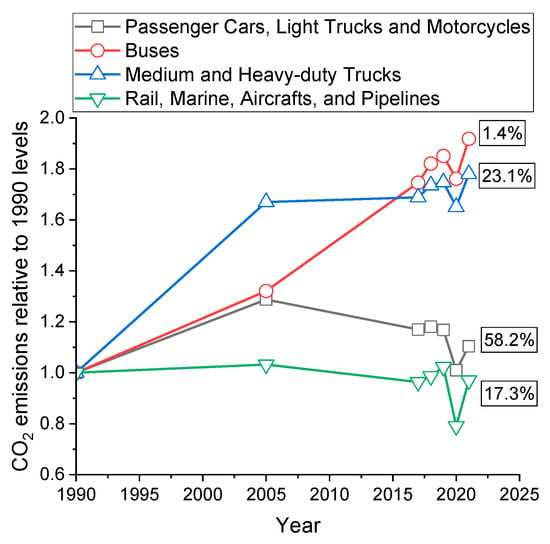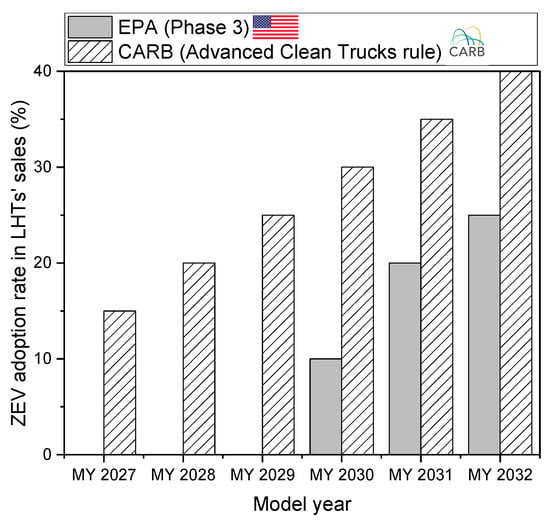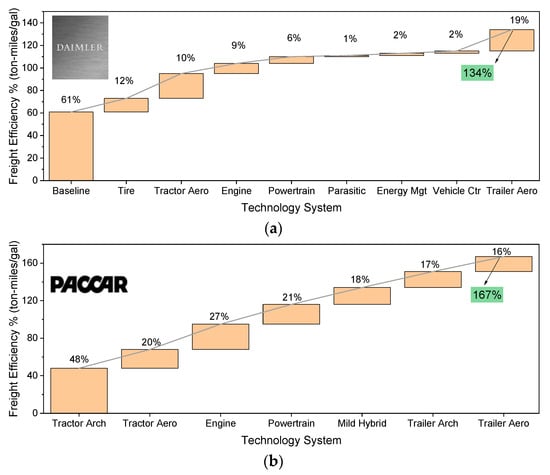2. LHTs Make-Up and Market
Road freight transport is a critical part of economic activity worldwide. It generates a turnover of more than €334 billion in Europe and provides jobs for 3.2 million Europeans
[3]. In North America, trucks are responsible for 66% of the trade between the U.S., Canada, and Mexico. All other modes, like air and rail, handle the remaining 34% of the freight
[4][5]. To meet these demands, annual commercial vehicle production globally is on the order of 10 M units. Manufacturers are primarily based in China (42% of global truck and bus production from 2016 to 2022), 21% in Europe, and 13% in the U.S.
[6]. There are relatively few OEMs for LHTs in all the main markets, as summarized in
Figure 1 [6][7][8]. Some of the main OEMs are active in both Europe and North America, including PACCAR (DAF and Leyland in Europe; Peterbilt and Kenworth in NA); Daimler (Freightliner and Western Star in NA); and Volvo (Mack in NA).
Figure 1. LHT OEM market share in (
a) the U.S. (2021), (
b) Western Europe (2017), and (
c) China (2016)
[6][7][8][9].
The carbon footprint of HDVs has increased considerably compared to other transportation sections. For example, in the U.S. (and similarly in Canada), as shown in
Figure 2, the CO
2 has almost doubled since 1990 for HDVs, showing that despite vehicle efficiency improvements, the total fuel consumption has risen due to an increasing road freight transport demand. Buses also showed a similar trend, although the GHG level of the light-duty sector has been almost stable since 1990. In Europe, CO
2 emissions from HDVs increased by 25% between 1990 and 2016, stemming from growing road transport demand
[9].
Figure 2. CO
2 emissions in the transportation sector in the U.S. relative to 1990; the values in the box show the 2021 CO
2 share in transportation—data obtained from
[10][11].
HDVs are categorized as light heavy-duty (GVWR of 8500 to 19,500 lbs), medium heavy-duty (GVWR of 19,501 to 33,000 lbs), and heavy heavy-duty (LHTs with GVWR exceeding 33,000 lbs). As seen in
Table 1, HDVs form only 2% of vehicles on the road in Europe and are responsible for one-fourth of the road transport CO
2 in the EU (and almost 6% of total EU GHG) and 31% of transport-related NOx emissions
[9][12][13]. HDVs show a similar GHG share in the U.S.
[14], and although they represent only 7.8% of the total road transport market, HDVs in China are responsible for 74% of transport NOx, 52.4% of road PM and 6.1% of all GHG emissions
[15].
Table 1. HDV share in road transportation emissions
[14][15][16][17].
Although light commercial vehicles in HDVs account for the largest market share, tractor–trailers, or LHTs, emit a major part of GHG and NOx emissions. For example, LHTs form 9% of the HDV fleet in the U.S. but emit almost half of the NOx emissions and half of the GHGs. Similarly, RHTs make up 5% of the HDV fleet and are responsible for 12% and 13% of the GHGs and NOx emissions, respectively
[17]. Moreover, in particular, LHTs emit 65% of the CO
2 emissions within HDVs in Europe
[16][18].
Moreover, LHTs are responsible for hauling almost 65% of goods (regarding the weight of the shipment)
[19] in the U.S. while using 28 billion gallons of fuel per year (22% of total transportation energy usage). Also, HDVs’ GHG emissions in the U.S. are almost 430 MMT CO
2 equivalent per year. Similarly, in Europe, these trucks account for almost two-thirds of road freight transport in vehicle kilometers
[20]. As a result, there is a significant opportunity for technology improvement to reduce emissions and fuel costs in this key sector. One of the main driving factors for these engine, powertrain, and vehicle parts improvements is stringent emission regulations, which will be discussed in the next section.
3. Drivers of LHT Fuel Consumption Reduction
Regulatory push and cost savings from fuel consumption reduction are the main drivers for the technology upgrades in commercial vehicles. The emission regulations for LHTs are categorized as GHG and meet the criteria for pollutant emissions. Regulatory limits aiming to reduce GHG emissions in LHTs vary between jurisdictions. Requirements for the U.S., EU, and China are summarized in
Figure 3. The U.S. Phase 2 and 3 regulations, when combined, require an almost 40% CO
2 reduction in LHTs in 2032 compared to 2021 levels
[21]. In February 2023, the European Union announced more ambitious fleet average targets for CO
2 reduction in HDVs, with 45% in 2030, 65% in 2035, and 90% in 2040 compared to 2019 levels
[12][22]. Finally, China is in phase 3 of the fuel consumption standard, which applies to all new 2021 heavy commercial vehicles with a 15% lower fuel consumption limit than the previous phase.
Figure 3. Overview of GHG regulations in different jurisdictions—data obtained from
[12][21][23].
In all cases, the regulations target vehicle tailpipe (not fuel-cycle) emissions reductions and are based on manufacturer sales-weighted annual new vehicle averages. The wide variety of HDVs means that type approval for individual vehicles, common in LDVs, would be prohibitively expensive. Instead, regulations combine ICE emissions and performance test results with vehicle simulations to provide consistent assessments across HDV platforms. European regulation uses a modeling tool called the Vehicle Energy Consumption Calculation Tool (VECTO), while in the U.S., the EPA uses the Greenhouse Gas Emissions Model (GEM). Although details differ, both tools combine ICE performance and emissions maps with powertrain (transmission, etc.) and vehicle configuration (load/weight, rolling resistance, drag) data over a series of defined drive cycles. GHG restrictions can be based on vehicle configuration: VECTO includes over 15 different classes of LHTs, while the EPA regulates different standards based on weight and vehicle configuration (e.g., day cab vs. sleeper cab). In the U.S., GHG emissions include tailpipe CO2 as well as other GHGs (including CH4 and N2O). In the EU, the regulations are for tailpipe CO2 only; emissions of other GHGs are captured under air pollutant emissions limits.
Along with fleet average GHG/CO
2 reductions, regulators are also implementing requirements for a fraction of new HDV sales of zero-emission vehicles (ZEVs). In NA, CARB is implementing ZEV requirements, as shown in
Figure 4, and the EPA estimated ZEV adoption rates as one potential technology pathway to meet the CO
2 standards
[24][25]. Similarly, in the European context, there is flexibility to comply with the CO
2 regulations determined by the zero- and low-emission vehicle (ZLEV) factor to reduce the manufacturer’s target by 3% depending on the number of produced ZLEVs
[26]. Moreover, the International Energy Agency (IEA) has projected that the share of battery electric trucks needs to be 25% by 2030 to comply with the Net Zero Emissions by 2050 Scenario (NZE)
[27]. Similarly, the share of battery electric vehicles in the medium and HD sectors is envisioned to reach 40% by 2040, based on the BloombergNEF report
[28]. It is significant to consider the required infrastructure and life-cycle implications of full powertrain electrification. Moreover, different factors, such as battery weight/size and their impact on cargo capacity and charging time, need to be better evaluated in ZEVs regarding long-haul trucking applications. According to the abovementioned optimistic ZEV adoption rates, the majority of new HDVs will still include an internal combustion engine as a key part of the propulsion system. Therefore, continuous work to improve efficiency and reduce GHG emissions from these vehicles is imperative in addressing climate change in the near term.
Figure 4. EPA projected the adoption of ZEV in LHTs, along with ZEV rates in California’s Advanced Clean Trucks rule
[29][30].
4. Technology Systems for Efficiency Improvement in LHTs
Commercial vehicles must meet stringent emission and CO
2 regulations alongside FE improvements to lower operational costs. Fuel-saving technologies for HDVs can be generally classified as engine, powertrain, or vehicle efficiency improvements. There are significant interactions: downspeeding, for example, leads to lower friction losses and hence higher engine efficiency but is only achievable through a combination of engine design to improve torque at low rotational speeds, combined with advanced transmissions incorporating more reactive shift strategies and a reoptimized final-drive ratio. To meet emissions targets, incremental technology improvements across all aspects of the LHT will be required. A good example of combining different technology pathways is a study by Pischinger et al.
[31] to reach the European 2030 CO
2 target defined in 2019 (note that this does not address the current, more aggressive restrictions from 2023). Different engine, driveline, and vehicle technologies are incorporated in the analysis as shown in
Figure 5; hybridization is recognized as a potential contributor, along with vehicle, engine, and powertrain control improvements.
Figure 5. Technology pathways to meet European 2025 and 2030 CO
2 regulations on LHTs
[31][32], adapted from Pischinger et al.
[31] and Joshi
[24]. CO
2 reductions are relative to a 2019 baseline. Studies were conducted prior to 2023 EU standards, so they do not incorporate the most aggressive CO
2 reductions.
Combining engine, driveline, and vehicle technologies is the key consideration in fuel economy improvement, as different papers showed a 20% to 40% FC reduction by combining these technologies. The long-term role of ICE and its centric role in hybrid systems are also highlighted in different studies due to progressive efficiency improvements
[33][34]. Buysse et al.
[33] underscored HD diesel engines’ crucial role in U.S. long-haul trucking using efficient technology systems. Their analysis showed a 24% CO
2 emissions reduction beyond the 2027 standard using a 55% brake thermal efficiency (BTE) engine, advanced predictive cruise control, and low-rolling resistance (LRR) tires. Also, further utilizing engine downspeeding, downsizing, and mild hybrids can reduce CO
2 emissions to 34% lower than the Phase II standard. Delgado and Lutsey
[35], simulating an LHT, showed that FE could be doubled by utilizing aerodynamic improvement, higher tire efficiency, downspeeding, downsizing, WHR, and hybridization. In a similar study, Delgado et al.
[36] evaluated the FE benefits of different technology packages in the 2020–2030 time frame by modeling an LHT. The results showed a potential 27% reduction in fuel consumption using commercialized technologies, such as low-rolling-resistance tires, aerodynamics, engine friction improvement, turbocompounding, and downspeeding. Also, implementing a 55% BTE engine model equipped with WHR and hybridization showed a further reduction in fuel consumption, i.e., 43% from the baseline.
By reviewing the literature on LHTs, the general contribution of engine, powertrain, and vehicle technologies to FE improvement is comparable with the results of Pischinger et al. This alignment is shown in Figure 6, which illustrates an overview of the current FE improvements in LHTs. Figure 6 results are from research papers evaluating different technology features in LHTs in the U.S. and Europe; the papers relied on simulation to assess FE benefits and selected different baseline LHTs. The details of engine, vehicle, and powertrain technologies will be discussed in the next sections.
Figure 6. FE contributors in the literature, based on simulation results for LHTs in the U.S. and Europe with different baselines
[31][33][37][38][39][40][41][42][43][44][45][46][47][48][49][50].
Similarly, in the SuperTruck II program, the participating OEMs have claimed freight efficiency (payload carried multiplied by distance covered divided by fuel consumed, i.e., ton-mil/gallon) improvements of more than 100%. These have been achieved by combining incremental improvements to multiple technology elements relating to the engine, powertrain, and vehicle, as shown in Figure 7.
Figure 7. OEM’s claimed efficiency benefits from technology elements as a share in freight efficiency improvement in the SuperTruck II program relative to the 2009 baseline vehicle for (
a) DAIMLER and (
b) PACCAR
[51][52].
The overview of the technological features of all the involved OEMs is summarized in
Table 2 [53]. The developed technologies range from improved engine efficiency to reduced weight and drag, along with enhancing powertrain efficiency by recuperating dissipated heat via a WHR system and converting that to electricity to be stored in the battery pack. As shown in
Figure 7, there is no single technology element that predominates the reported improvements in freight efficiency. Rather, incremental improvements are achieved across a wide range of system components. The details of the selected technologies vary between OEMs, but engine efficiency, powertrain optimization, and vehicle resistance reductions all make important contributions for all the project teams. The primary benefit is to reduce vehicle resistance and fuel consumption through efficiency improvements and system optimization. Weight reduction to increase payload within permitted gross vehicle weights has a secondary effect on the overall freight efficiency improvements. The details of the engine, powertrain, and vehicle side improvements will be discussed in the next sections.
Table 2. Technology systems in the DOE SuperTruck II Program
[24][51][52][54][55][56][57][58][59].
| OEMs |
Daimler |
Volvo |
Cummins/Peterbilt |
PACCAR |
Navistar |
| Engine, Combustion, and Air Management |
|
-
High CR:20,
-
Peak cylinder pressure of 250 bar
-
Wave piston
-
Thermal barrier coatings
-
LIVC (late intake valve closing)
-
Aggressive Miller cycling
-
Turbo-compounding
-
Long connecting rod
-
2700 bar high pressure (HP) common rail system
|
-
Low heat transfer
-
Reduced friction
-
High efficiency turbo
-
Downspeeding
|
|
|
| Hybrid Architecture |
48 V mild hybrid- P2; better than belt starter generator (BSG) |
Integrated starter/generator (ISG) mounted on the rear power take-off (PTO) connected via a two-speed gearbox |
|
-
48 V mild hybrid
-
PTO 30kW e-motor
|
|
| Battery |
7 kWh Li-ion |
14 kWh Li-ion |
|
10 kWh Li-ion |
|
| After-treatment |
|
-
Electrically heated catalyst
-
High cell, thin wall subs.,
-
Low back pressure with short DPF/SCR,
-
Pre-turbine catalyst (lower back pressure, improvement in NOx)
|
|
|
-
Upstream SCR/AMOX combination
-
Heated diesel exhaust fluid (DEF) injector
-
Electric heater 0.15 g/bhp-h NOx demonstrated (FTP comp)
|
| Waste Heat Recovery |
-
Phase change engine cooling system
-
50 bar and 305 °C with a 60/40 water/ethanol mixture
-
159 kW “vapor” power
-
Heat sources: cylinder head, EGR cooler, engine block, tailpipe boiler
-
~ +4.4% BTE
|
-
Cyclopentane and an unspecified refrigerant
-
48 V electric power system
-
Heat sources: exhaust and engine coolant (dual loop)
-
~ +2–3% BTE
|
-
Dual entry turbine
-
Providing up to 10.5–11 kW mechanically connected
-
Heat sources: coolant, charge, exhaust, and EGR
-
+4.4% BTE
|
-
Organic Rankine Cycle (ORC) based dual-loop WHR system
-
Dual entry turbine
-
Heat sources: coolant + exhaust, charge air cooler (CAC), and oil heat recovery
-
≥4% BTE target
|
-
ORC cycle
-
48 V eTurbine expander
-
Exhaust tailpipe evaporator
-
Low temperature (LT) and high temperature (HT) working fluid loops
-
Heat sources: exhaust, coolant, multi-stage charge air
|






 5%
5% 2%
2% 7.8%
7.8%








